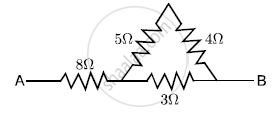Advertisements
Advertisements
प्रश्न
The filament of a bulb takes a current 100 mA when potential difference across it is 0.2 V. When the potential difference across it becomes 1.0 V, the current becomes 400 mA. Calculate the resistance of filament in each case and account for the difference.
उत्तर
According to Ohm's law,
V = IR
∴ R = `"V"/"I"`
`therefore "R"_1 = "V"_1/"I"_1`
= `0.2/0.1 = 2 Omega`
Similarly ,
`"R"_2 = "V"_2/"I"_2`
= `1/0.4`
= 2.5 Ω
Resistance of the wire increases with increase in temperature. So the difference arises because the temperature of the filament increased.
APPEARS IN
संबंधित प्रश्न
What is an Ohmic resistor?
What is Resistivity?
Calculate the current flowing through a wire of resistance 5 Ω connected to a battery of potential difference 3 V.
A wire of resistance 9 ohm having length 30 cm is tripled on itself. What is its new resistance?
Calculate the effective resistance across AB?

Define the following:
(i) Coulomb
(ii) Ohm
Draw a neat diagram for the verification of Ohm’s law by voltmeter-ammeter method. By another diagram show the relation between p.d. and current.
Explain the equivalent resistance of a parallel resistor network.
Ohm's law deals with the relationship between ______

Vinita and Ahmed demonstrated a circuit that operates the two headlights and the two sidelights of a car, in their school exhibition. Based on their demonstrated circuit, answer the following questions.
- State what happens when switch A is connected to:
a) Position 2
b) Position 3 - Find the potential difference across each lamp when lit.
- Calculate the current.
a) in each 12 Ω lamp when lit.
b) In each 4 Ω lamp when lit.
OR - Show, with calculations, which type of lamp, 4.0 Ω or 12 Ω, has the higher power.
